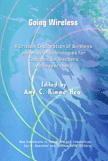Part IV: Teaching and Learning in Motion—Mobility and Pedagogies of Space.
In Part IV, the book returns to the issue of the intersection among ideas of space, composition, and wireless communications environments. Because the idea of mobility is itself so tied up with space, and because space has become such an important discussion in composition theory in recent years, the authors in this section find rich ground for theoretical discussion.
The section opens with Hea's "Perpetual Contact: Re-articulating the Anywhere, Anytime Pedagogical Model of Mobile and Wireless Composing," which provides the book's first in-depth exploration of the "anywhere, anytime" expectation that wireless technologies bring with them. Hea takes a look at what she calls "cultural narratives of ubiquity," first looking at arguments and implementations made in favor of making our computing environments ubiquitous, then applies those narratives to two specific cases of ubiquitous computing initiatives: the first being Vail School District's initiative to replace textbooks with laptops, and the second being the One Laptop Per Child nonprofit group. She chooses these two initiatives, one local and one global, to demonstrate how important space is to thinking about mobile and wireless technologies—that even ubiquitous computing, despite is universalist aspirations, is situated.
What Hea's article exposes is the way that ubiquitous computing reinforces the utopian determinist stance that technology is neutral and unproblematic. She reminds us that
we must strive for complex, dynamic praxis of teaching and research with, through, and about wireless and mobile technologies, and we must come to view those technologies as both enabling and constraining certain aspects of our lives. (p. 206)
This recognition that technologies can constrain as well as enable is important when theorizing or advocating for critical engagement with any technology, and as Hea demonstrates with this article, teachers and students should "question and even enact situated—rather than placeless—pedagogies of mobile and wireless technologies" that take into account local issues, instead of being theorized in a universal space that pretends to be neutral (p. 217).
Olin Bjork and John Pedro Schwartz follow Hea with "Writing in the Wild: A Paradigm for Mobile Composition," an exploration of the use of wireless and mobile technologies for not only researching in the field, but composing and publishing as well. Building on Sirc's call to bring the outside in, Bjork and Schwartz propose thinking about sites of composition outside of traditional writing spaces—spaces such as the classroom, the dormitory, or the home.
Though the authors are careful to note that composing "in the wild" can take place with a pen and paper just as easily as it can with wireless and mobile technologies, the article is still more about the affordances that mobile and wireless technologies give us as teachers and students: "Wireless networks have the potential to redefine the classroom as any physical or virtual place where instructors and students happen to meet" (p. 229). They go on to describe three types of on-the-scene writing already taking place that could be of use in the composition classroom: "the use of smart phones to create a museum of everyday life" (in which writers send MMS messages documenting and interpreting objects, places, events, etc. of interest) (p. 231), sound-seeing (a kind of tourism based on sound rather than sight), and the moblog ("text, audio, photos, and video posted to blog from a mobile device") (p. 233).
What I find most interesting about these forms of writing is that they address one of the more fundamental problems of teaching both process and the traditional essay. The authors are careful to point out that we should not abandon the traditional essay, but the problem we currently face is that the practice of drafting, as we currently teach and enact it, is too artificial for the writing processes that we have developed from our use of desktop publishing (as Nedra Reynolds pointed out in 2004). The genres Bjork and Schwartz propose as possible additions to the composition class are designed around on-the-spot publication. Their process is part of the product, rather than being obscured by the product. This can open discussion and thinking about writing process in ways that traditional process models tend to ignore.
Part IV closes with Nicole R Brown's "Metaphors of Mobility: Emerging Spaces for Rhetorical Reflection and Communication," in which she proposes using graffiti and public art as metaphors for mobile composition. Because both art forms depend on their situatedness to work and even exist, Brown sees them as useful metaphors for talking about writing assignments in which we expect our students to write "in a particular time and within a particular place" (p. 249). Brown notes that because of the cultural associations and rootedness of graffiti, we must be careful in the metaphor's deployment, and that even the graffiti artist's situatedness as between two worlds: the outsider as well as citizen, serves as a perfect metaphor for the spaces in which we want our students to write if they are to engage subjects of importance.
Brown is also careful to note that both metaphors, rather than one or the other, are important because "something is inevitably gained and something is inevitably lost as we attempt to create a composing process using these metaphors" (p. 247), and so teachers and theorists who find her metaphors fruitful should take note. What is important to take away is that Brown finishes with "Kathleen Blake Yancey's (2004) call for the socially aware remediation of text to create new and dynamic genres and literacies" (p. 249), both in using mobile technologies in the writing classroom and in using Brown's metaphors for teaching with them.
